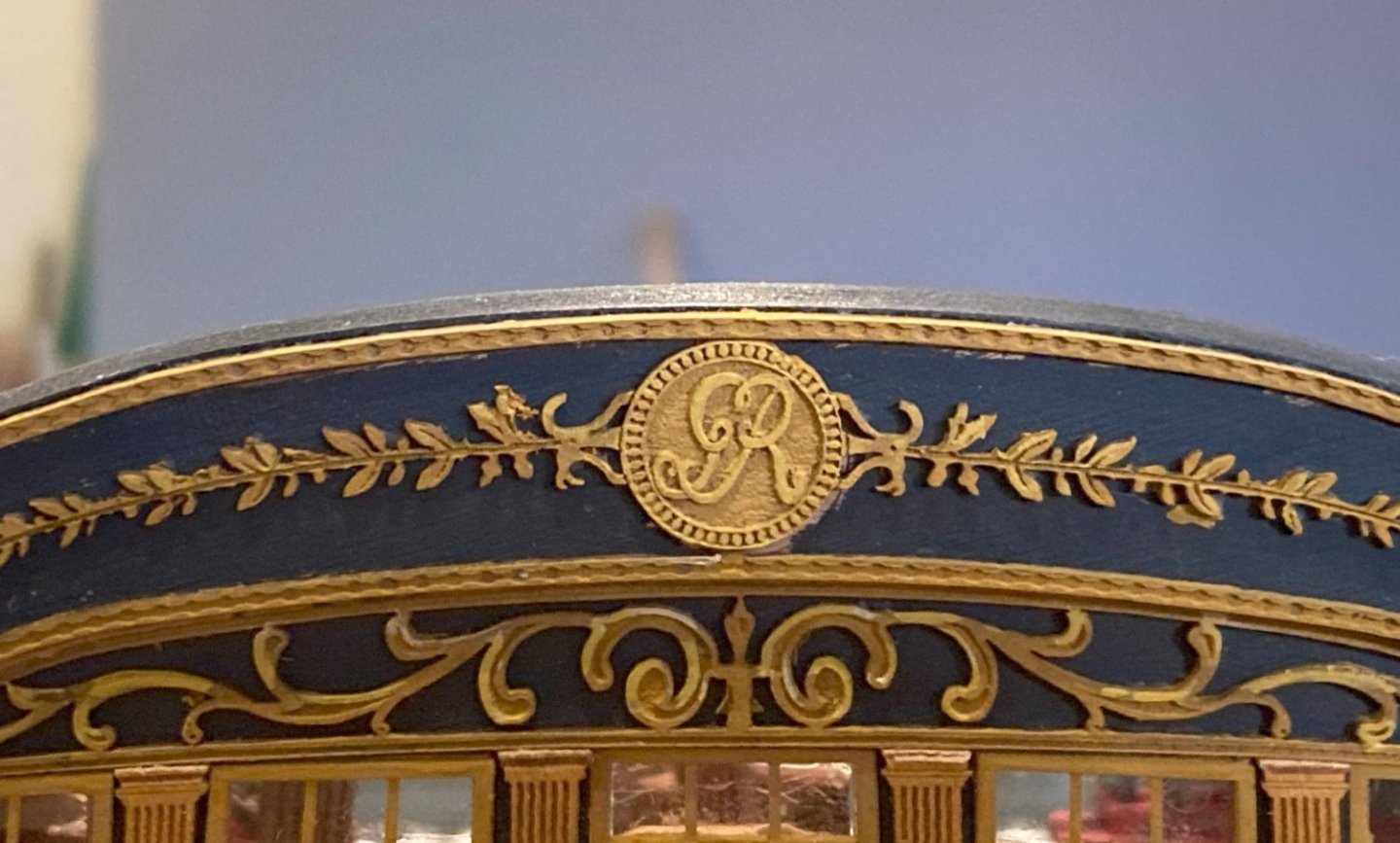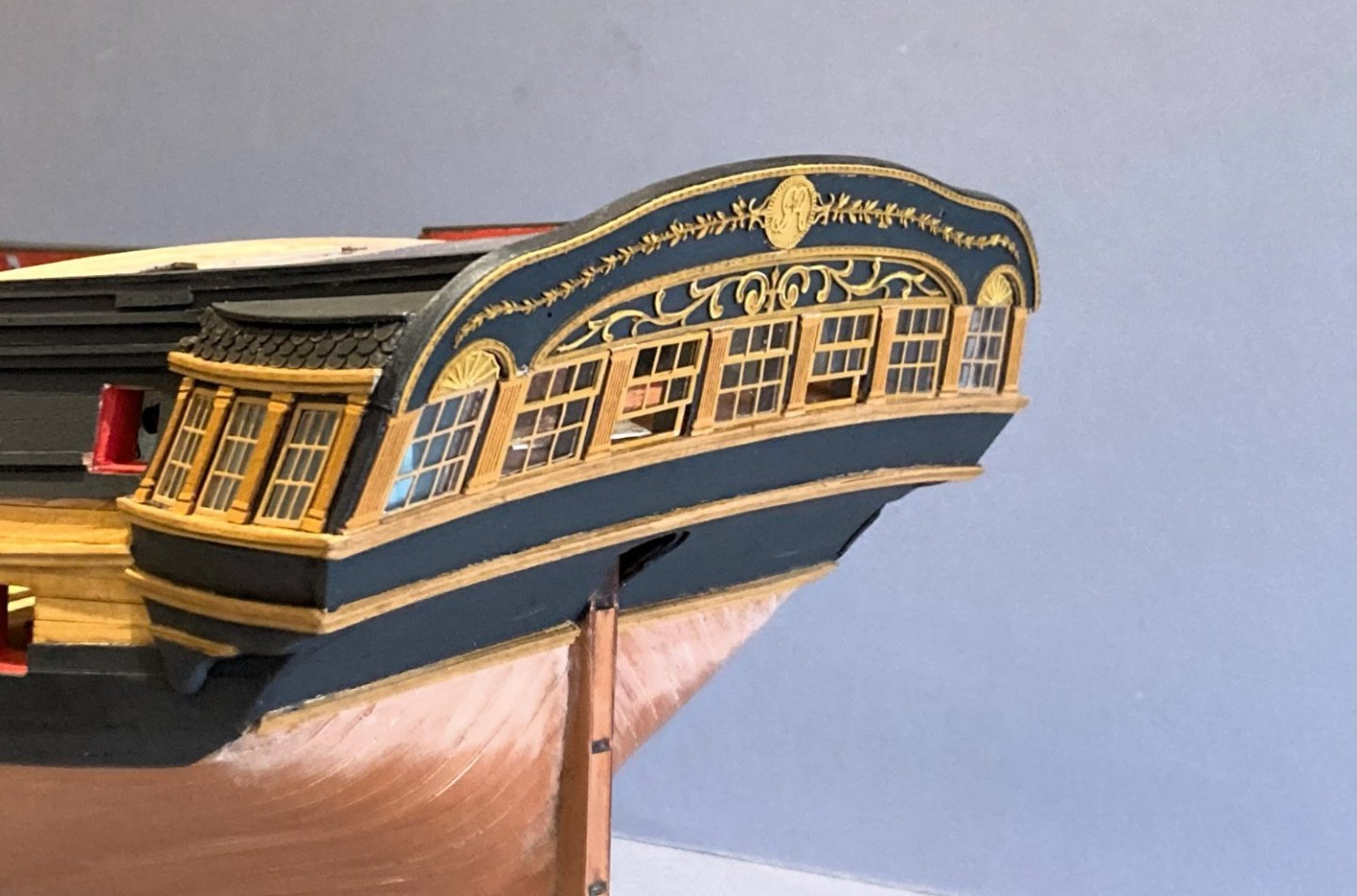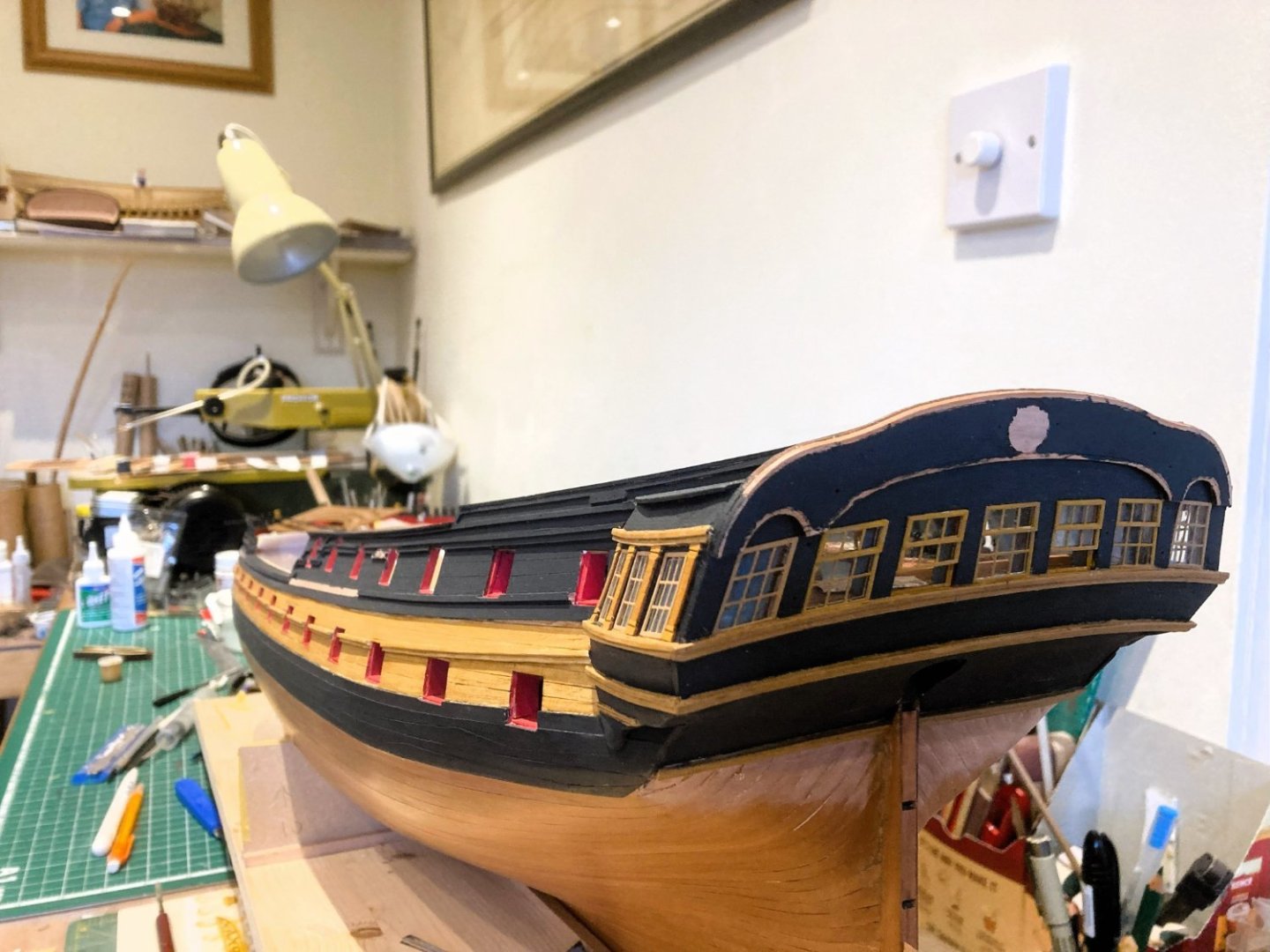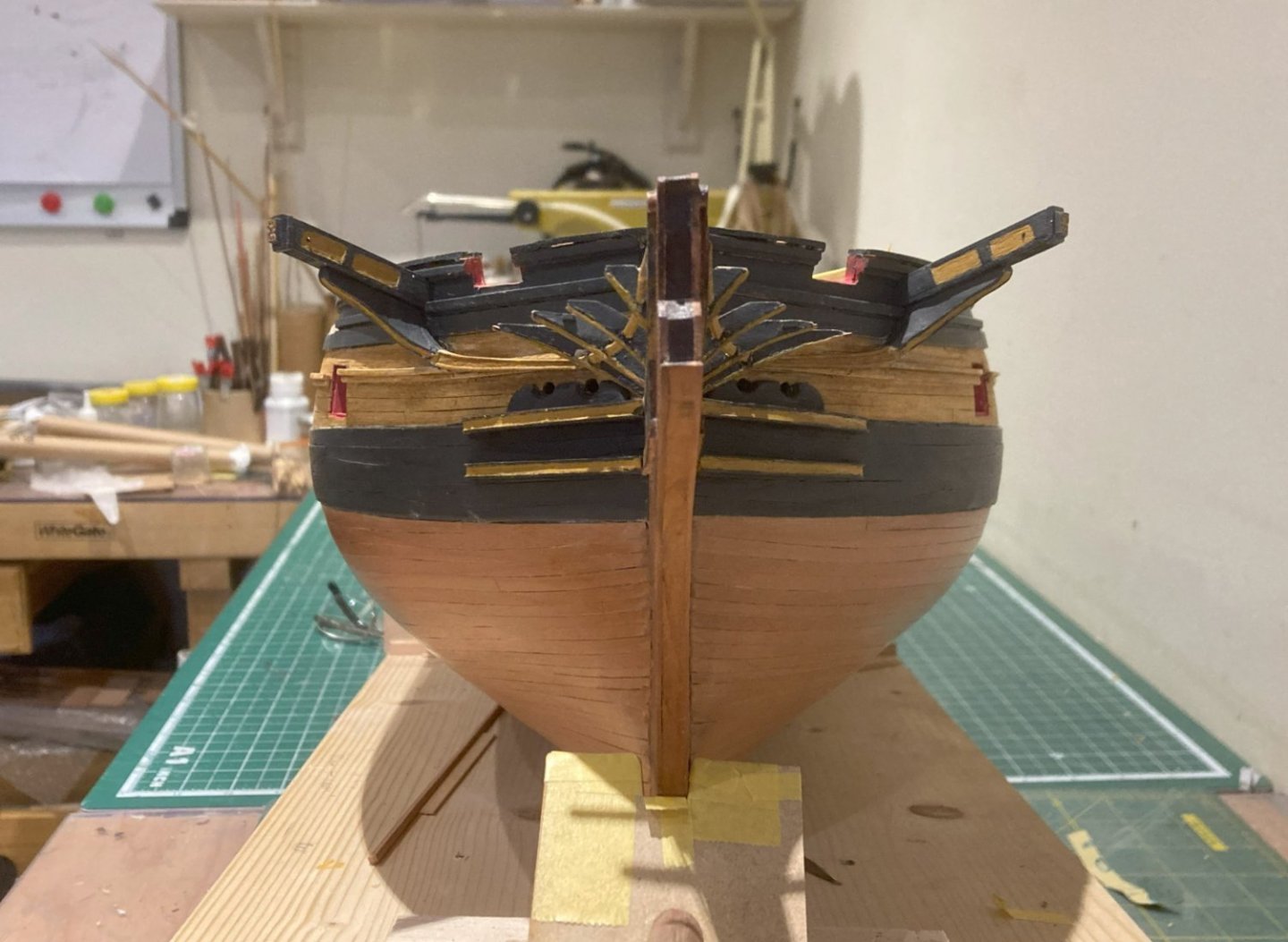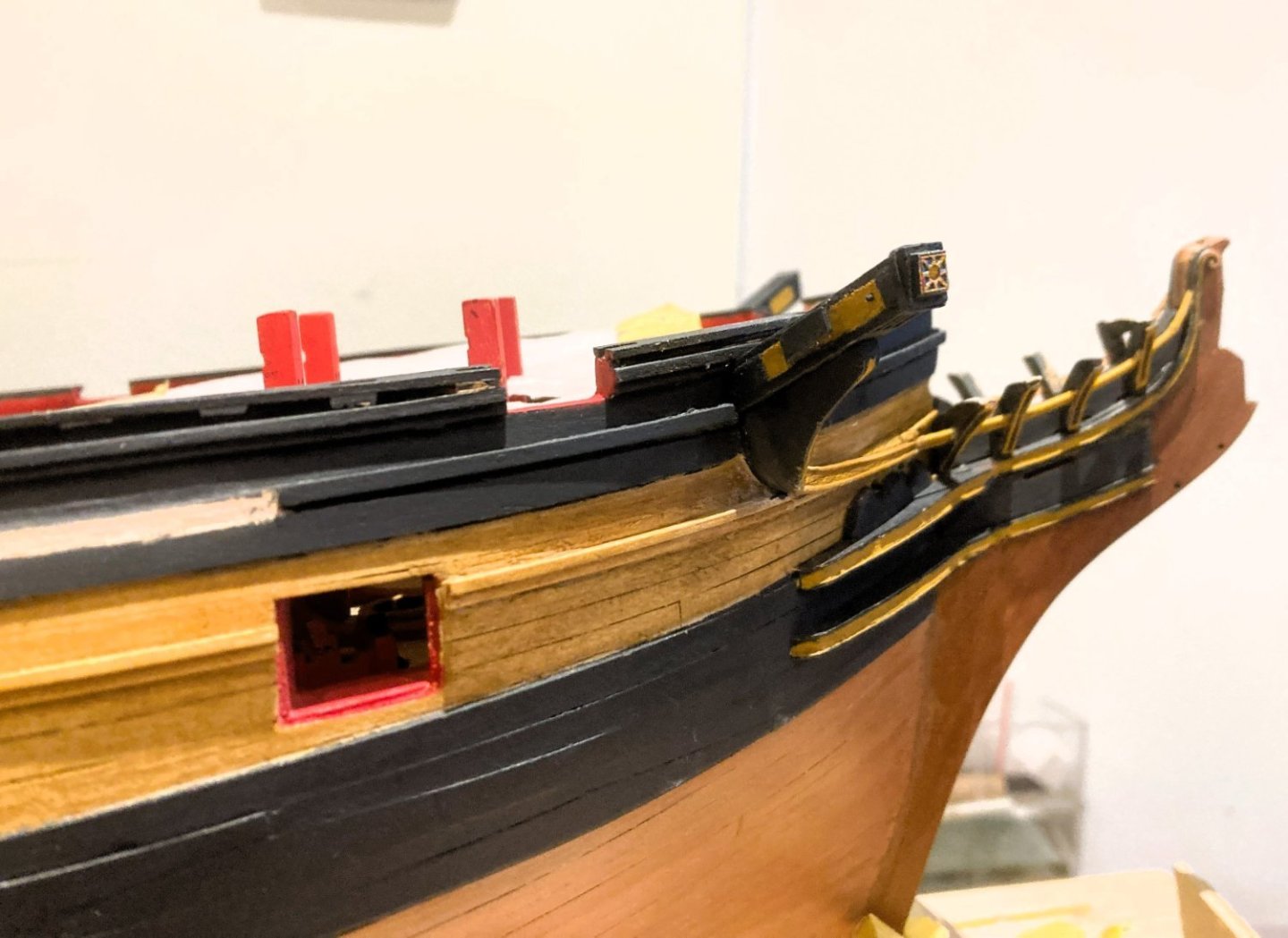-
Posts
4,240 -
Joined
-
Last visited
Content Type
Profiles
Forums
Gallery
Events
Everything posted by Blue Ensign
-
Post One hundred and Twenty-two Re-visiting the Poop The position of the skylight is still something of a puzzlement for me. 3141 The original position as indicated on the Adm plans is over the Coach, the standard position for skylights. 3143 With the shortened Poop deck Chris has re-positioned it over the Great cabin, on the basis that this would be a practical move. 3144 Aesthetically, with the reduced Poop, it looks much better than the usual position over the coach. The Skylight has been raised by 2mm to compensate for the absence of planking. 3145 The new position does beg the question whether a skylight over the Great Cabin, with its access to extensive light thro’ the stern, is really necessary. We do know that Pellew didn’t want the round house at all, but the reduced length was as far as the Navy Board would concede. Pure speculation, but it seems to me that Pellew might well have dispensed with a Skylight altogether, on the basis that it wasn’t necessary and presented an additional weakness to the structure. 3146 3150 Even so, it is a nice little feature that adds interest to the Poop deck, along with the Mizen Bitts which still seem to be oddly positioned to my eye. Still ‘Indy’ is a knocked about Sixty-four, so who knows.🤔 B.E. 26/12/2023
- 637 replies
-
- Indefatigable
- Vanguard Models
-
(and 1 more)
Tagged with:
-
Post One hundred and Twenty-one Completing the stern decoration This comprises Acanthus leaf designs and a plaque with the Royal cipher. 3109 Before I fitted the pilasters between the lights, I added the decoration for the cove. I found it best to do this before fitting the pilasters. 3108 The Pilasters did need a light sanding across the tops to fit the available space. 3111 I decided to add a capping rail to the transom to hide the laminations of the stern. On 'Indy' I used Boxwood, but thin styrene strips are also suitable. Roof shingles Chris has provided pre-cut card versions that do very nicely. 3113 The lower two strakes were fitted as strips, the upper one individual tiles trimmed to suit. The remaining stern decoration followed. 3135 1634A 3133 1639A 3121 3116 This Polybak decoration works very well, but great care must be taken particularly with the long delicate string attached to the cipher. Break this and there may be difficulties in matching the smooth flow of the design. My last post before Christmas, so seasons’ greetings to all my fellow builders, and many thanks for those who have liked and shown interest in my builds over the year. B.E. 23/12/2023.
- 637 replies
-
- Indefatigable
- Vanguard Models
-
(and 1 more)
Tagged with:
-
Beautiful detailing Nils, always a pleasure to see your work. 👍 B.E.
- 330 replies
-
Post One Hundred and Twenty Lights and Frames I always view this job with a degree of trepidation. I started by using ‘Future’ (now Klear) Applied with a brush to the glazing surface the frame was placed on top and allowed to set. Once dry a bead of Future was painted around the reverse edge. I had mixed success with this. The Qtr gallery lights were more stubborn and I resorted to applying tiny spots of odourless ca to the back of the frame, and carefully placing the glazing. 3095 I removed the protective covering from the front side, and partly peeled the aft side which I used to hold the glazing for positioning. This ideally needs to be done as a one-shot effort, to reduce the risk of ca spread. I did have to replace the glazing on several lights due to marring, cut from the glazing fret. Fitting the frame/glaze combo by comparison is easy, the merest pass along the edges with a file, and they do indeed ‘pop into place.’ I started with the Qtr lights, and once they’re fitted it makes a significant difference to the look. This is Chris’s best Qtr Gallery innovation to date, the seat of ease is clearly visible and with the Gallery door left open the light flows thro’ enhancing the realism. 3103 3105 Addition of the fluted pillars completes the effect. For the stern I opted to have only two of the sashes open as per Jim’s prototype build, I thought this gave the most balanced and aesthetically pleasing effect. 3101 All the stern light glazing pieces were attached to the frames using ‘Future’ prior to fitting. The Upper sash frames were attached to the frames using odourless ca. 1620a Onto the decoration. B.E. 22/12/2023
- 637 replies
-
- Indefatigable
- Vanguard Models
-
(and 1 more)
Tagged with:
-
Nice work on the rattlin' down Glenn, no hint of shroud distortion. 👍 Personally I'm not keen on inking the ratlines post fitting for fear of ink spray on the decks. If I'm going to blacken the ratlines I dye the line first, but on my version I'm spared that task. The decks look nice and shipshape. B.E.
-
HMS Indefatigable - 1:64 scale – The Art of Age of Sail I just randomly came across this, another 1:64 scale kit out of MarisStella To early to say how it will compare with Vanguard's kit, but there are some photos on the link above. B.E.
-
Thank you, James, I’m aware of ‘Klear’, or ‘Future’ as it was called last time I used it, beloved of model aircraft builders for canopy fixing and finishing. I’ll certainly give it a go with odourless ca as a back-up. Regards, B.E.
- 637 replies
-
- Indefatigable
- Vanguard Models
-
(and 1 more)
Tagged with:
-
Thank you Nils.👍 Post One Hundred and Nineteen. Back to the blunt end Time to attend to the unfinished stern. I had figured out on the bow area how to finish the Pearwood mouldings and pilasters to be used on the stern. 3088 Vallejo Ochre Brown over the Pear followed by a coating of the water-based wood stain I used on the Boxwood hull timbers. This gives a fair match to the varnish hull finish. 3086 The stern is otherwise painted in Vallejo Black/grey. 3085 3084 3091 3093 3094 When it comes to the frames for the lights I have seen examples of white frames which look quite attractive. However, they would be the only white elements on the model so I am sticking with Ochre Brown. 3080 The frames are prepared on the fret, priming with Metal prep 4K, followed by two coats of Ochre brown. The trickiest part of this exercise will be fitting the frames without marring the ‘glass’ with glue smears. Tomorrow’s interesting little exercise. 🫤 B.E. 18/12/2023
- 637 replies
-
- Indefatigable
- Vanguard Models
-
(and 1 more)
Tagged with:
-
That looks an excellent build of these tricky little boat hulls. 👍 B.E.
- 20 replies
-
- 24 ft Launch
- Vanguard Models
-
(and 1 more)
Tagged with:
-
Cheers Guys, and thanks for the support with the 'likes'. The figure is now back in the box for safety. B.E.
- 637 replies
-
- Indefatigable
- Vanguard Models
-
(and 1 more)
Tagged with:
-
Post One hundred and eighteen Thoughts about the Figure This seems a good time to check out the Figure. The resin warrior version provided by Chris is a mini work of art, beautifully detailed and styled. 2998 We don’t know what Figure ‘Indy’ actually had, but the choice of a Bronze age Greek Warrior fits perfectly. During the late 18thc it was practice to paint Figures in natural colours, rather garish looking in some cases. I have been pondering how to finish the figure, and I’ve concerns that too bright a finish may clash with the more muted tones of my build. I have several books on the subject, but contemporary ship models of this period with ‘painted’ figures are hard to find. A lot of Navy board models are without figures, and for those that have them they are usually either gilded or varnished. For ‘Indy’ I want to use more muted tones with reduced contrast between the shades. How that will turn out I’ve no idea at this point, but I first need to wash and prime the figure. 3002 3006 I use Vallejo Surface primer which shows up the detail beautifully. Before I start painting, I create a colour chart of the likely shades I will use. 3032 These are painted over the primer coat so I can determine the coverage required. 3038 Incidentally, these little lidded 3.5ml pots obtained from Amazon are ideal for paint mixing small quantities and keep it fresh for a long time. I painted the model in life colours but aimed for a soft tone. Vallejo paints were used throughout. This is the result. 3068 3071 3073 3074 3078 I think the colours tone in very well, and the figure sets off the model beautifully. I am particularly pleased with the Bronze used on the metal work, and the Red for the cloak which has a dark wine colour. The reinforced linen of the Pteruges (skirt) were painted with Dark sand, and the tassels in Ivory. For skin tones I opted for Ochre brown with a spot of Burnt Umber added. The shield is Hull Red with the embossed hub and rim in Bronze. I had intended to apply washes and varnishes, but I’m now thinking I should quit while I’m ahead. It is after all a figurehead on a ship not a real-life depiction as may be created for a specific model figure. A pleasant diversion from recent activity, but back to the build now. B.E. 15/12/2023
- 637 replies
-
- Indefatigable
- Vanguard Models
-
(and 1 more)
Tagged with:
-
Post One hundred and seventeen Timberheads Not much to say about these, a little chamfering around the tops and ensuring that those flanking the gunports are vertical, and the others line-up. 3008 The much larger tops of the two knightheads or Bollards either side of the Bowsprit opening are the tricky ones. 3011 These need to be positioned accurately and appear vertical from all angles. 3009 The final addition are the snatch blocks for the Cat tackle. I added a sheave for these, cut from a slice of 3mm ø dowel. 3018 3027 3028 A little light sanding, a re-coat and they should be good to go. B.E. 13/12/2023
- 637 replies
-
- Indefatigable
- Vanguard Models
-
(and 1 more)
Tagged with:
-
Post One Hundred and Sixteen Completing the Headworks Gluing the Main rails in place is always a critical business. 2971 I fitted the Starboard side first which went on without issue, the pieces held using pva and sectioning clips. 2980 I took the precaution of marking the level above the capping rail on the Port side rail to assist fitting. 2978 2975 Always a relief once this part is completed. 2992 I am pleased to see that the level looks good athwartships. Not part of the kit is the Saddle. 2996 This is a section of timber triangular in shape, that spans the Main rails where they converge at the back of the head and effectively ties them together. 2982 For the convenience of the crew I have added two additional seats of ease positioned at the aft end of the gratings adjacent to the False Rail. In the Indy kit the False rail is an integral part of the Main Rail, and contains the Capsquare for the Boomkin. The Headwork construction battle is now over, but I still need to do some tidying up and redo’s on the paintwork, but that I can do at my leisure. B.E. 11/12/2023
- 637 replies
-
- Indefatigable
- Vanguard Models
-
(and 1 more)
Tagged with:
-
Sometimes it is useful to dry test well in advance of actual fitting to avoid any issues that may arise later on. On my build I can see that the angle of the Capsquare will need to be adjusted, and possibly the seats of ease profile modified. B.E.
- 637 replies
-
- Indefatigable
- Vanguard Models
-
(and 1 more)
Tagged with:
-
Thank you Glenn, have you tried the fit of of your Boomkins yet? B.E.
- 637 replies
-
- Indefatigable
- Vanguard Models
-
(and 1 more)
Tagged with:
-
Post One Hundred and Fifteen Main Rails These are the most prominent rail of the Headworks and require careful positioning. The laser cut parts are very nicely done and contain extra length. Accurate trimming is required for a good fit, I removed 11mm from the fore end. 2957 The Main rail should look elegant and I fined down the forward end where it meets the Hair bracket. I also tapered it on the inside as it runs towards the bow. A gentle heat bend was applied to the forward end, forward of the Capsquare, to provide a less stressed fit to the hair Bracket. 2959 A slightly risky business but the bend is very shallow, not much is required. To finish these Pearwood parts, Vallejo Ochre Brown is used for the first coats, followed by my wood dye mix which produces a close match to the Boxwood varnish finish. 2965 The panel detail is black ink. 2966 2968 Dry fitting the rails. As I played around with these rails I noticed that the Capsquare for the boomkins looked close by the seats of ease. This may cause issues with the Boomkin fitting. 2969 Plan sheet 9 shows the Capsquares sitting aft of the seats of ease which would allow a clear line of fitting. All the build photos I’ve seen seem to show the position adjacent to the seats of ease, but no one has reached the stage of fitting Boomkins yet. It will be interesting to see how the other members of the ‘Class of ’23 get on with this fitting. I hope to get the rails fixed in position today but I suspect it may take a while. B.E. 10/12/2023
- 637 replies
-
- Indefatigable
- Vanguard Models
-
(and 1 more)
Tagged with:
-
It doesn’t feel much like fun for me at present but we go thro’ the full gambit of emotions with model building. The excitement of a new project, the boredom of doing repetitive routine elements, the frustration when things go wrong, the elation when things go right, the relief when a tricky element is successfully completed, and the pleasure of a project completed to satisfaction. For me model building is a deeply absorbing activity, the research, the interaction with fellow builders on MSW, the striving for improvement, I couldn’t be without it in my life. ☺️ @ Darius – Thank you, - at present I don’t think I’m doing her justice! but that will pass.🤞 Regards, B.E.
- 637 replies
-
- Indefatigable
- Vanguard Models
-
(and 1 more)
Tagged with:
-
Post One Hundred and Fourteen Headworks (Part Four) The next stage is fettling and dry fitting the gratings over the head timbers. This piece is delicate and needs careful handling, I took the precaution of making a template to get the profile before applying it to the actual part. 2875 2941 ….but I still managed to split it at the weak points during the necessary sanding to fit. 2945 With the aft grating fixed the forward section is added. 2947 The fourth timberhead (nearest the bow) is left as is in the kit scheme but there would be a cross timber atop or aft of this known as the cross-piece of the head, very simple to add. There is also an open space between the third and fourth timber heads which looks unfinished to my eye. A check around indicates that there should be carlings running between the two, which are added using some 0.8mmx1mm pear strip. These are also simply added. The kit contains the makings for the seats of easement for which the hole looked a tad large to my eye, but on checking such details out, Chris has it spot on. 2952 I considered that a ship the size of Indy would have had an extra set of seats fitted, which I intend to add. (I did the same on Sphinx) 2955 2956 I persuaded my Skipper from the Zulu Muirneag to try them our for size, it did cost me a dram.😉 Slàinte, B.E. 08/12/2023
- 637 replies
-
- Indefatigable
- Vanguard Models
-
(and 1 more)
Tagged with:
-
Post One Hundred and thirteen Headworks (Part Three) One of the trickiest parts to get right is the Cathead supporter and I did struggle to get the necessary curve to fay into the Ekeing rail even with Chris’s unique, as far as I know, jig which goes a long way towards resolving the problem of the complex curves involved. Ideally the top of the supporter should be square and centred beneath the Cathead, and curve down to follow exactly the curve of the Ekeing rail. My initial attempts resulted in a mismatch between the two. The problem could be addressed to some extent by bevelling the top of the supporter but there was still an obvious misalignment. I scrapped my first attempts and I re-made the supports using a lamination of three pieces of 1mm stuff. Even so it took a couple of re- shapings in the jig to get a result that just about passed muster. 2890 The Cathead supporter/ekeing rail arrangement on the kit is a simplification. The Supporter in reality, was a separate piece to the ekeing rail and should be fastened close to the hull, with the ekeing fayed into its lower end. 2897 Once fitted, even tho’ superficially it may look ok, blind man on a galloping horse comes to mind, I was not happy with the result. The main issue is that the supporter knee is glued to the Ekeing rather than the hull, resulting in a gap between hull and rail where the Ekeing passes over the upper wale and waist rails, which throw it away from the hull. The manual only indicates removing a small section of rail directly beneath the cathead, and the result is that the supporter is then obviously attached to the rail rather than the hull and not attached to the hull at all at the lower extreme. This made little sense and irritated my eye each time I looked at it. 2900 I needed a re-think, so all my work of the past few days was undone. 2902 Fortunately, the supporter and rail came away without breakage. A contributing factor is that the Ekeing runs atop and almost parallel with the Waist rail rather than cutting it at a more acute angle to run below it as indicated on the plans (both kit and official) My aim is to get the supporter to look as if it is fastened directly to the hull, and to achieve this it is necessary to fine down the waist rail to allow the supporter to sit flush with the hull. The aft side of the supporter is also built up to compensate for the gap between Upper rails and Waist rails. 1584a This modification is still a bit of a fudge but I can now live with it. 2914 1588b 2918 There’s a lot of work left to do on the finish, and getting clean lines on the mouldings is also proving a challenge. I need to wait for better light for detail painting, the light levels in the UK are very poor at present. The Bow saga goes on….. B.E. 07/12/2023
- 637 replies
-
- Indefatigable
- Vanguard Models
-
(and 1 more)
Tagged with:
-
Thanks Dave, I’m not sure having fun is the right term – grim determination more likely.😬 @ Allan - The approach is probably different on a scratch build, you need all the rails etc in order to determine the head timbers. With Indy this has already been determined, but even so it is a good idea not to commit to glue too soon in the process. 🤔 Cheers, B.E.
- 637 replies
-
- Indefatigable
- Vanguard Models
-
(and 1 more)
Tagged with:
-
Post One Hundred and Twelve Headworks (Part Two) With the Head timbers in place the Lower rail can be fitted. These are the ones that run along the slots in the Head timbers to join the Hair bracket at the fore end and the Ekeing rail aft. The kit blurb indicates fitting the decorative cover panels to the head timbers and slotting the rail through them before fitting to the hull. 2851 I prefer to fit the rails on the model and then add the covers. I temporarily fitted the first cover to help hold the rail during positioning. The provided slots do err on the generous side, presumably to allow trouble free access. Some remedial work will be required post fitting. Looking at the manual photos the rail terminates on the Waist rail that runs between the gunports up to the bow. The plans show the rail meeting the ekeing rail which runs just below the termination of the Waist rail. It is almost inevitable to get some variation in position due to the vagaries of individual builds, but with the head timbers in place (not glued) I can test the rail and see how it all pans out. 2866 Fitting the Lower rails is quite a tricky operation, these are delicate parts and I managed to break the tip off one, fortunately the repair held. Cathead completion This involves adding the caps and decorative motif and the cleat for the Cathead stopper. The decorative motif on the cap is a star design neatly laser cut. Ekeing rail This runs from beneath the Cathead to meet the Lower rail just below the previously fitted Waist rail, or in my particular case at the lower edge of the waist rail. 2872 2874 It is a composite of two parts; (inner214) and outer (212/213) I have confirmed with Chris that the inner (214) is a ‘spare’ but could be used to bulk out the Ekeing rail if desired. I believe it did taper in thickness as it runs towards the Lower rail, so I opted to use it, looks better to my eye. 2870 As an aside, David Steel The elements and practice of Naval Artchitecture 1812) is rather scathing about the Ekeing rail. The Ekeing rail at the low part of the supporter under the Cathead is only to continue the shape and fashion of that part, being of no other service. We make this remark because if the supporter was stopd short without an Ekeing, it would be better, as it causes the side timbers to rot, and it commonly appears fair to the eye in but one direction. Not many years later and by the time of the Leda class frigate Trincomalee the Ekeing seems to have been dispensed with. Onto the delights of the Cathead supporter. B.E. 05/12/2023
- 637 replies
-
- Indefatigable
- Vanguard Models
-
(and 1 more)
Tagged with:
-
Post One Hundred and Eleven Painting the Topsides The past couple of days amongst other stuff I have been applying some paint to the hull. I had been keen to get an idea of how my intended scheme was going to look. I am not following the designated scheme with the colour bands following the deck line rather than the sheer, and as a Navy board style depiction, I don’t need to. I have scraped the Boxwood section back to bare wood, the previously coloured w-o-p over English light Oak wood dye had suffered some deterioration over the past few months due to handling during construction. A coat of Vallejo Black/grey has been applied to the topsides. This is the result. 2839 2837 2838 2841 Getting there, but rub-downs and re-coats will be needed to get a finish I’m happy with. The Boxwood will be re-coated using the w-o-p/wood dye combo. B.E. 25/11/2023
- 637 replies
-
- Indefatigable
- Vanguard Models
-
(and 1 more)
Tagged with:
About us
Modelshipworld - Advancing Ship Modeling through Research
SSL Secured
Your security is important for us so this Website is SSL-Secured
NRG Mailing Address
Nautical Research Guild
237 South Lincoln Street
Westmont IL, 60559-1917
Model Ship World ® and the MSW logo are Registered Trademarks, and belong to the Nautical Research Guild (United States Patent and Trademark Office: No. 6,929,264 & No. 6,929,274, registered Dec. 20, 2022)
Helpful Links
About the NRG
If you enjoy building ship models that are historically accurate as well as beautiful, then The Nautical Research Guild (NRG) is just right for you.
The Guild is a non-profit educational organization whose mission is to “Advance Ship Modeling Through Research”. We provide support to our members in their efforts to raise the quality of their model ships.
The Nautical Research Guild has published our world-renowned quarterly magazine, The Nautical Research Journal, since 1955. The pages of the Journal are full of articles by accomplished ship modelers who show you how they create those exquisite details on their models, and by maritime historians who show you the correct details to build. The Journal is available in both print and digital editions. Go to the NRG web site (www.thenrg.org) to download a complimentary digital copy of the Journal. The NRG also publishes plan sets, books and compilations of back issues of the Journal and the former Ships in Scale and Model Ship Builder magazines.



